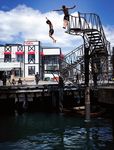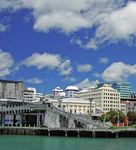ICMP NEWS Wellington City - Wellington Water
←
→
Page content transcription
If your browser does not render page correctly, please read the page content below
ISSUE 2
JUNE 2015 Wellington City
ICMP NEWS
An Integrated Catchment Management Plan (ICMP) is a plan for the sustainable management of fresh and coastal water and ecosystems.
In this issue
Welcome to the second edition of ICMP News
which focuses on the Lambton Harbour catchment
wastewater network and ongoing investigations.
Lambton Harbour catchment
Wastewater networks
Wellington Water implements a proactive
programme to investigate the condition
of “critical” wastewater pipes.
Keeping it in the pipes
Wellington Water is committed to monitoring,
identifying and remedying wastewater
contamination into stormwater networks.
Further areas of investigation
ICMP Process
Wellington City’s First step - produce Next step - prepare detailed
stormwater discharge a Stage 1 Report. Stage 2 ICMPs. To be
consents were granted. Completed - March 2014. completed by March 2018.
Stage 2 requires detailed investigations to identify management options for minimising catchment issues. Some of the Stage 2
tasks are being carried out as part of Wellington Water’s “business as usual ”operations as defined by Wellington Water’s Three
Waters Strategic Plan and Regional Asset Management Plan.
Work done since March 2014 Lambton Harbour
Stage 2 work to date: catchment (Shaded area)
- developed Stage 2 Project Plan
- identified investigation requirements
- determined indicative action plans
- engaged industry experienced professionals to complete
pipe network modelling.
Where are we at now?
We are currently focussing on detailed assessments of the
wastewater and stormwater networks in the Lambton Harbour
catchment.
Want to stay in touch and get involved? Get on our newsletter list: info@wellingtonwater.co.nzLambton Harbour catchment
The Lambton Harbour catchment consists of a mix of dense, high-rise commercial offices, retail malls, hotels, clusters
of restaurants and bars, and residential apartment blocks.
This image illustrates the dense and high rise nature of the catchment.
The Lambton Harbour catchment stretches from the northern coast along
Aotea Quay to the beach front of Oriental Bay, and collects stormwater from
the Lambton basin, stretching as far south as Aro Valley, Mt Cook and Newtown.
Its commercial activities include the Port of Wellington, Inter-island ferry
terminals, and a large marina. Recreational amenities include the waterfront,
Oriental Bay beaches and boat launching and mooring facilities. In addition to
the dense development in the Lambton basin, the catchment has large open
areas, including the Botanic Gardens and Tinakori Hill. The neighbouring areas
surrounding the CBD have low to medium density residential areas.
The stormwater drainage system of the Lambton Harbour catchment discharges
into Wellington Harbour. Eleven major outfalls are located between the Overseas
Passanger Terminal and the Blue Bridge Ferry Terminal.
Population growth
Much of the Lambton Harbour catchment wastewater pipeline system Over coming years the population of
is old. Pipe age and structural condition are often factors that affect the the Lambton Harbour catchment is
infiltration to, or exfiltration from, pipe networks. These factors largely anticipated to increase significantly.
contribute towards a decline in stormwater quality. This population growth will place
Whilst progressive renewals of the public wastewater network pipes pressure on existing stormwater and
are being undertaken, very little maintenance takes place in the private wastewater networks.
network. The majority of the older pipes in the network are earthenware
or concrete. Population projection for Lambton
Harbour catchment
Present day wastewater sources (approximation) (Reference: Forecast ID, 2011).
80,000
70,000
10 - 15% 60,000
Domestic and commercial
sources 50,000
15% 40,000
70% Industrial flows 30,000
20,000
Groundwater infiltration 10,000
into the system 0
2011 2016 2021 2026 2031
YEARWastewater networks
Today the proportion of wastewater pipe
1890s Between 1915 & 1960 materials within the catchment is:
The earliest parts Most of Wellington’s drainage network was EW
of Wellington’s constructed.
wastewater The majority of the wastewater network in PE
network were Lambton Harbour catchment is mortar jointed 18% Concrete
established. earthenware, brick or concrete pipes.
Brick
59% 10%
Steel
Today Today most of the wastewater pipes are earthenware 5%
4% Iron
(EW), and other common pipe materials comprising of
polyethylene (PE) and concrete. Asbestos
2% Cement
2%
Wellington Water has a proactive programme to investigate and maintain the condition of wastewater pipes and its
operation. This investigation work programme consists of the following:
Environmental monitoring and Flow monitoring to assess the wastewater
sanitary surveys flow volumes in relation to pipe capacity
Overflow monitoring of:
CCTV (closed-circuit television) inspection
• constructed overflow weirs which are activated in programme to identify pipes that are damaged or
wet weather, when flows exceed pipe capacity blocked, for example, by fat build ups or tree roots
• reticulation overflows, which happen if pipes get
blocked, in wet or dry weather Subcatchment wastewater modelling assess
• pump stations, when wastewater inflows exceed the capacity of individual pipes and the overall
pump or storage capacity performance of the piped wastewater network
These programs are used to assess the condition of the assets and to identify pipe renewal and maintenance methods.
Keeping it in the Wellington Water Limited
pipes - preventing Committed to monitoring, identifying and
remedying wastewater contamination.
We have a pollution investigation team to
pollution identify the causes of pollution incidents
and implement procedures to help prevent
recurrence.
Stormwater often can be contaminated by wastewater in different ways: pipe leakage due to age/state of condition,
pipe blockages, private network faults, and wet weather overflows which occur when the pipe capacity is exceeded by
stormwater entering into the system.
Work in progress - based on information gathered under different work programmes:
Determining the location of pollution Considering how the condition of the
sources within Lambton Harbour wastewater network has affected the
stormwater quality results observed
Interpreting the results of stormwater Identifying potential methods to manage
quality samples taken over recent years in and reduce pollution within Wellington
catchments leading to the Lambton harbour HarbourFurther investigation areas
A detailed investigation has been undertaken in order to find pollution sources and reduce pollution within Lambton Harbour
catchment. Information used during this investigation includes:
• Stormwater quality samples collected since 1 July 2012
• Existing structural condition of wastewater pipes
• Levels of risk associated with any potential structural failure within the wastewater network
• Existing land use.
The investigation has identified potential contaminant source areas for theLambton Harbour catchment. Source areas were
categorised into priority areas and caution areas. In order to verify the extent of pollution in these areas more thorough
investigation and analysis is required. The following additional actions will be carried-out to identify issues and solutions.
• More in-depth CCTV and water quality monitoring
• Education and awareness programmes on potential accidental and illegal discharges
• Flow and overflow monitoring by installing flow meters and depth sensors.
Potential contaminant source areas for the Lambton Harbour catchment are shown in the map below.
Lambton Harbour catchment potential contaminant source areas Pipes CCTVed since 2007
About 41% of public wastewater pipes have been
inspected since 2007 in the Lambton harbour
catchment to determine pipe conditions.
90
80
70
60
50
40
30
20
10
0
2007 2008 2009 2010 2011 2012 2013 2014
YEAR
For more information or to contact us: Document Number: ICMP NEWS - 2
visit www.wellingtonwater.co.nz or phone 04 910 3800 Date: JUNE 2015You can also read

























































